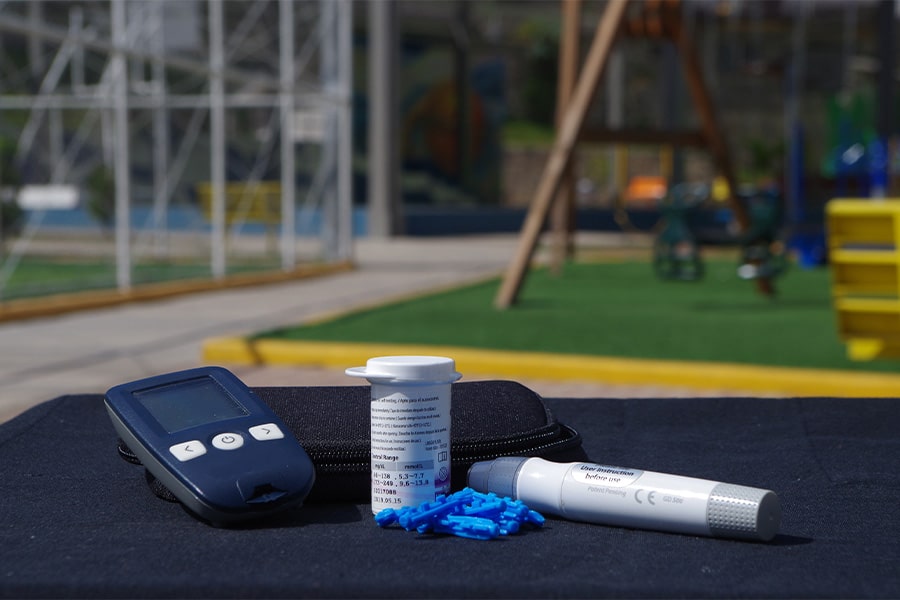What is diabetes?
We’ve all heard of diabetes, or might know someone with it, but what exactly does it mean?
When someone has diabetes, their body cannot maintain healthy levels of glucose (a form of sugar, which is the main energy source for our bodies) in the blood. Unhealthy levels of glucose in the blood may lead to both long-term and short-term health complications.
What are the types of diabetes, and how can they be managed?
There are three main types of diabetes: type 1 diabetes mellitus (T1DM), type 2 diabetes mellitus (T2DM; “lifestyle diabetes”), and gestational diabetes (GDM).
Type 1 diabetes accounts for 10-15% of all cases and is generally diagnosed at a younger age. Type 1 Diabetes is an autoimmune condition in which the immune system is activated to destroy the cells in the pancreas which produce insulin. People with type 1 diabetes require insulin injections several times a day or are required to use an insulin pump to ensure they have an optimal amount of insulin available.
Type 2 diabetes or “lifestyle” diabetes accounts for about 85% of all diabetes. Type 2 Diabetes is often a progressive condition in which the body becomes resistant to the normal effects of insulin and/or gradually loses the capacity to produce enough insulin in the pancreas. Type 2 diabetes is linked to modifiable lifestyle risk factors including high blood pressure, overweight or obesity, insufficient physical activity, and poor diet. You are also at higher risk of developing type 2 diabetes if you have a family history of diabetes. Initially, type 2 diabetes can be managed with healthy eating and regular physical activity, however as it progresses medication and insulin injections may also be required for management. Type 2 diabetes is the fastest growing chronic condition in Australi, and you can use the Diabetes Australia Risk Calculator to estimate your risk of developing type 2 diabetes within the next five years: https://www.diabetesaustralia.com.au/risk-calculator
Gestational diabetes is a form of diabetes that occurs during pregnancy. Most women will no longer have symptoms after the baby is born, however some women will continue to experience high glucose levels after delivery. Risk of developing type 2 diabetes later in life is increased in women who have gestational diabetes, and the baby may also be at increased risk of developing type 2 diabetes. Gestational diabetes can often be managed with healthy eating and regular physical activity, however some women may also need medication and/or insulin injections.
How can exercise help?
According to the Australian Physical Activity and Sedentary Behaviour Guidelines, it is important to accumulate 150 – 300 minutes per week of moderate intensity exercise, or 75 – 150 minutes of vigorous exercise per week to obtain health benefits.
Benefits of exercise include:
- Improved mood and sleep
- Improved muscle strength and bone mass
- Lowered blood glucose levels (BGLs)
- Lowered cholesterol and blood pressure
- Improved heart health and blood vessel health
- Maintaining or achieving a healthy body weight
- Reduced stress and tension
- Improved mental health
Evidence has shown that type 2 diabetes can be prevented or delayed in up to 58% of cases by maintaining a healthy weight, being physically active, and following a healthy eating plan.
Exercise cannot reverse the damage to the cells in the pancreas that leads to the decreased production of insulin, however exercise can improve the way the muscles respond to insulin, which in turn helps regulate the blood glucose level for some hours after the bout of exercise. Exercise also increases glucose uptake by the muscles in other ways that do not depend on insulin. In addition, exercise can lower the dose of insulin required by improving the body’s response to insulin.
What type of exercise should I do?
Research has shown that all forms of exercise – aerobic, resistance, or both (combined training) are equally as good at lowering HbA1c values (relates to the amount of glucose in the blood) in people with diabetes.
Resistance training and aerobic exercise both help to lower insulin resistance in previously sedentary older adults with abdominal obesity at risk for diabetes. Combining the two types of exercise proved more beneficial than doing either one alone.
Increasing your incidental physical activity or decreasing sedentary behaviours is also helpful – for example, taking the stairs instead of the lift, getting up to change the TV instead of using the remote control, completing housework, and doing gardening.
General guidelines for diabetes and exercise:
While exercise has many benefits, there may also be risks. People with diabetes are at increased risk of heart and blood vessel disease and foot problems, so it is important that their exercise programs are appropriate and tailored to decrease risk.
- If you have never exercised before, start with low impact exercise such as walking or strength training and go slowly. This will help build exercise tolerance and prevent injuries.
- Consider seeing an accredited exercise physiologist for an individualised program. This is especially helpful if you have pain or limited movement.
- Discuss with your doctor or diabetes educator the most appropriate areas of the body to inject your insulin, especially during exercise.
- Wear appropriate footwear and comfortable socks to prevent foot ulcers. Regular foot checks are recommended.
- Check your blood glucose levels (BGLs) before, during, and after exercise to see how the exercise you are doing affects them. Checking every 30 minutes during and after exercise for a few hours is recommended, particularly if exercise is new to you.
- Time your exercise sessions appropriately. Exercise is not recommended during peak insulin action (often 1-2 hours after injection, depending on your insulin type), so consider when your last meal or medications were taken.
- Exercising in the early morning is recommended to avoid peak insulin action. At this time of day, insulin is generally lower (prior to any insulin taken for breakfast).
- Exercising before bed is not recommended given the risk of delayed post exercise hypoglycaemia. If you do exercise before bed, it is sometimes recommend that you complete a 3am BGL check.
- Keep glucose tablets or lollies with you while exercising in case your blood sugar drops quicker than expected.
What resources are available if I have diabetes?
- Under the Medicare system, any Australian with Type 1 & 2 diabetes can access a variety of services to help manage and control their diabetes. This includes Medicare-funded individual or group sessions with an accredited exercise physiologist. Contact your GP for more information.
- In NSW, people with diabetes can attend the ‘Beat It’ program which runs over 8 weeks and involves moderate intensity aerobic, strength, and balance-based exercises as well as education sessions on healthy living topics. These programs often run at community groups and hospitals. Contact the NDSS Info line on 1800 637 700 to find the Beat It program nearest to you.
- The National Diabetes Services Scheme (NDSS) has developed free online modules to learn more about how to live well with Type 2 diabetes. This can be accessed via the following link: https://www.ndss.com.au/services/support-programs/type-2-diabetes-and-me-online-course/
Author: Queenie Liang, AEP ESSAM
Sources:
- Diabetes and exercise (n.d.). Retrieved July 14, 2021, from https://www.diabetesaustralia.com.au/food-activity/exercise/
- Diabetes and exercise (n.d.). Retrieved July 14, 2021, from
https://www.betterhealth.vic.gov.au/health/conditionsandtreatments/diabetes-and-exercise - The importance of exercise when you have diabetes. (2021, February 03). Retrieved July 14, 2021, from https://www.health.harvard.edu/staying-healthy/the-importance-of-exercise-when-you-have-diabetes
- Diabetes and exercise (n.d.). Retrieved July 14, 2021, from https://exerciseright.com.au/diabetes/



